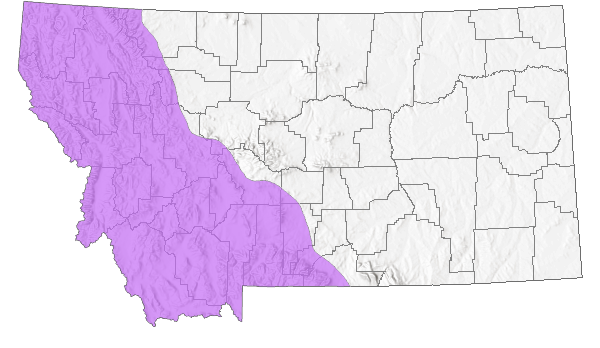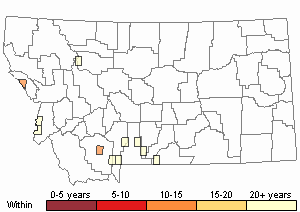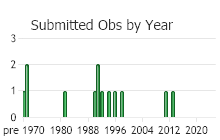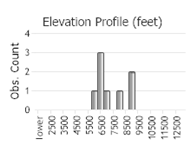View in other NatureServe Network Field Guides
NatureServe
Montana
Utah
Wyoming
Idaho
Wisconsin
British Columbia
South Carolina
Yukon
California
New York
Small-winged Sedge - Carex stenoptila
State Rank Reason (see State Rank above)
A globally rare species, which is known from several widely scattered locations in Montana. Very little data are available for the species in Montana, as the sites are known only from specimen collections with sparse information.
- Details on Status Ranking and Review
Population Size
Score2 - Small: Generally 2,000-10,000 individuals.
CommentEstimated. Population levels are undocumented.
Range Extent
Score2 - Regional or State Endemic or Small Montana Range: Generally restricted to an area <100,000 sq. miles (equivalent to 2/3 the size of Montana or less) or Montana contributes 50% or more of the species’ range or populations OR limited to 2-3 Sub-basins in Montana.
CommentRegional endemic of southern Montana, Wyoming, Colorado and Utah.
Area of Occupancy
Score1-2 - Low to Moderate. Occurs in 4-25 Subwatersheds (6th Code HUC’s), though the species' distribution is not sufficiently documented to place it within one class.
CommentAdditional populations likely exist and the species is probably under-collected and over-looked.
Environmental Specificity
Score1 - Moderate: Species is restricted to a specific habitat that is more widely distributed or to several restricted habitats and is typically dependent upon relatively unaltered, good-quality habitat (C Values of 5-7).
CommentHabitat does not appear to be especially unique or rare.
Trends
Score0-1 - Stable to Minor Declines:
CommentTrends unknown, though populations are likely stable or experiencing only minor declines.
Threats
Score0-1 - Low to Medium.
CommentPopulations are generally in more remote locations and in habitats that typically are not subject to heavy human use. Most documented occurrences are from trailsides though this is likely a result of opportunistic collections being made rather than it being representative of its true distrubition across the landscape.
Intrinsic Vulnerability
Score0-1 - Low to Moderate Vulnerability.
Raw Conservation Status Score
Score
6 to 10 total points scored out of a possible 19.
General Description
Small-winged Sedge forms clumps with stems that are 2-8 dm high and which arise from short rhizomes. The few leaves, 1-4 mm wide, are flat and clustered near the base. Flowers are clustered in 7-10 spikes aggregated into a tight head at the top of the stem. The female perigynia occupy most of the spike, with only a few inconspicuous male flowers (recognized by old stamens) at the base. The light brown perigynia are narrowly lance-shaped and 4-5 mm long, with a gently tapered tip that is entire-margined, deeply cleft, and round in cross-section at the tip. There are 5-7 nerves on the convex outer face of the perigynia. The dark to pale brown scales are smaller than the perigynia that they subtend. There are 2 stigmas. The seed is lens-shaped and fills the body of the perigynium.
Phenology
Fruiting in July-August.
Diagnostic Characteristics
Carex stenoptila belongs to a large group of very similar sedge species. A technical manual and hand lens or microscope will be needed for positive identification. In the more common Carex microptera, the seed does not fill the flattened perigynia. Carex phaecocephala has scales as long as the perigynia. Carex macloviana, C. multicostata, and C. pacystachya have more egg-shaped perigynia.
Species Range
Montana Range
Range Descriptions

 Native
Native
Range Comments
MT, WY, UT and CO (Lesica et al. 2012. Manual of Montana Vascular Plants. BRIT Press. Fort Worth, TX).
Observations in Montana Natural Heritage Program Database
Number of Observations: 13
(Click on the following maps and charts to see full sized version)
Map Help and Descriptions
Relative Density

Recency



 (Observations spanning multiple months or years are excluded from time charts)
(Observations spanning multiple months or years are excluded from time charts)
Habitat
Dry, often rocky soil of open forests and moist soil along streams. Montane and subalpine.
Stewardship Responsibility
Threats or Limiting Factors
STATE THREAT SCORE REASON
Threat impact not assigned because threats are not known (MTNHP Threat Assessment 2021).
References
- Literature Cited AboveLegend:
 View Online Publication
View Online Publication Lesica, P., M.T. Lavin, and P.F. Stickney. 2012. Manual of Montana Vascular Plants. Fort Worth, TX: BRIT Press. viii + 771 p.
Lesica, P., M.T. Lavin, and P.F. Stickney. 2012. Manual of Montana Vascular Plants. Fort Worth, TX: BRIT Press. viii + 771 p. MTNHP Threat Assessment. 2021. State Threat Score Assignment and Assessment of Reported Threats from 2006 to 2021 for State-listed Vascular Plants. Botany Program, Montana Natural Heritage Program, Helena, Montana.
MTNHP Threat Assessment. 2021. State Threat Score Assignment and Assessment of Reported Threats from 2006 to 2021 for State-listed Vascular Plants. Botany Program, Montana Natural Heritage Program, Helena, Montana.
- Additional ReferencesLegend:
 View Online Publication
View Online Publication
Do you know of a citation we're missing? Hermann, F. J. 1970. Manual of the Carices of the Rocky Mountains and Colorado Basin. Agricultural Handbook No. 374. USDA Forest Service. 397 pp.
Hermann, F. J. 1970. Manual of the Carices of the Rocky Mountains and Colorado Basin. Agricultural Handbook No. 374. USDA Forest Service. 397 pp. Jones, W. W. 1901. Preliminary flora of Gallatin County. M.S. Thesis. Bozeman, MT: Montana State College. 78 pp.
Jones, W. W. 1901. Preliminary flora of Gallatin County. M.S. Thesis. Bozeman, MT: Montana State College. 78 pp. Lesica, P., M.T. Lavin, and P.F. Stickney. 2022. Manual of Montana Vascular Plants, Second Edition. Fort Worth, TX: BRIT Press. viii + 779 p.
Lesica, P., M.T. Lavin, and P.F. Stickney. 2022. Manual of Montana Vascular Plants, Second Edition. Fort Worth, TX: BRIT Press. viii + 779 p.
- Web Search Engines for Articles on "Small-winged Sedge"





